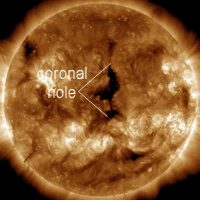WEEKEND GEOMAGNETIC STORM LIKELY: NOAA forecasters estimate a 60% to 70% chance of polar geomagnetic storms this weekend. A CME ejected from the sun on Aug. 21 is expected to hit Earth's magnetic field on Aug. 24, with reverberations from the impact continuing through Aug. 25. High-latitude sky watchers should be alert for auroras. Aurora alerts: text, voice.
ONE LESS COMET: Subtract one from the Solar System's total count of comets. Yesterday a small unnamed comet dove into the sun and completely evaporated. Click on the image to see the death plunge, animated:
The icy comet, R.I.P., was a member of the Kreutz family. Kreutz sungrazers are fragments from the breakup of a single giant comet many centuries ago. They are seen falling into the sun dozens of times a year. This particular sungrazer measured a few tens of meters in diameter, too small to survive a close approach with the sun.
A much larger sungrazer is on the way. Comet ISON (not a member of the Kreutz family, but a sungrazer nevertheless) will fly through the sun's atmosphere on Thanksgiving Day 2013. Unlike yesterday's tiny comet, Comet ISON is expected to survive its brush with death. The nucleus of ISON is probably wider than 0.5 kilometers, too big to completely evaporate during its transit of the sun's atmosphere. If optimistic estimates are correct, Comet ISON could emerge post-Thanksgiving as one of the brightest comets in many years.
First, however, Comet ISON is paying a visit to Mars on Oct. 1st, giving Mars rovers and satellites a sneak preview of a potentially-Great Comet. Watch this NASA video for details.

Solar wind
speed: 452.2 km/sec
density: 3.2 protons/cm3
explanation | more data
Updated: Today at 1507 UT
X-ray Solar Flares
6-hr max: B7 0930 UT Aug24
24-hr: B7 0930 UT Aug24
explanation | more data
Updated: Today at: 1500 UT
![]()
Daily Sun: 24 Aug 13
None of these sunspots poses a threat for strong solar flares. Credit: SDO/HMI
![]()
Sunspot number: 127
What is the sunspot number?
Updated 24 Aug 2013
Spotless Days
Current Stretch: 0 days
2013 total: 0 days (0%)
2012 total: 0 days (0%)
2011 total: 2 days (<1%)
2010 total: 51 days (14%)
2009 total: 260 days (71%)
Since 2004: 821 days
Typical Solar Min: 486 days
Update 24 Aug 2013
The Radio Sun
10.7 cm flux: 132 sfu
explanation | more data
Updated 24 Aug 2013
![]()
Current Auroral Oval:
Switch to: Europe, USA, New Zealand, Antarctica
Credit: NOAA/POES
![]()
Planetary K-index
Now: Kp= 2 quiet
24-hr max: Kp= 3 quiet
explanation | more data
Interplanetary Mag. Field
Btotal: 6.7 nT
Bz: 1.2 nT north
explanation | more data
Updated: Today at 1507 UT
![]()
Coronal Holes: 23 Aug 13
Solar wind flowing from the indicated coronal hole should reach Earth on Aug. 26-27. Credit: SDO/AIA.





